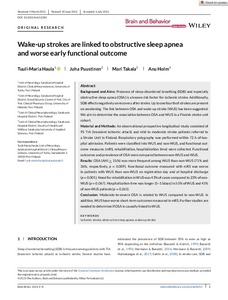Wake-up strokes are linked to obstructive sleep apnea and worse early functional outcome
Haula Tuuli-Maria; Takala Mari; Holm Anu; Puustinen Juha
https://urn.fi/URN:NBN:fi-fe2021093048012
Tiivistelmä
Background and Aims: Presence of sleep-disordered breathing (SDB) and especially obstructive sleep apnea (OSA) is a known risk factor for ischemic stroke. Additionally, SDB effects negatively on recovery after stroke. Up to one fourth of strokes are present on awakening. The link between OSA and wake-up stroke (WUS) has been suggested. We aim to determine the association between OSA and WUS in a Finnish stroke unit cohort.
Material and Methods: An observational prospective longitudinal study consisted of 95 TIA (transient ischemic attack) and mild to moderate stroke patients referred to a Stroke Unit in Finland. Respiratory polygraphy was performed within 72 h of hospital admission. Patients were classified into WUS and non-WUS, and functional outcome measures (mRS, rehabilitation, hospitalization time) were collected. Functional outcomes and prevalence of OSA were compared between non-WUS and WUS.
Results: OSA (AHI > 15/h) was more frequent among WUS than non-WUS (71% and 36%, respectively, p = 0.009). Functional outcome measured with mRS was worse in patients with WUS than non-WUS on registration day and at hospital discharge (p = 0.001). Need for rehabilitation in WUS was 43% of cases compared to 23% of non-WUS (p = 0.067). Hospitalization time was longer (5-15days) in 55% of WUS and 41% of non-WUS patients (p = 0.261).
Conclusion: Moderate-to-severe OSA is related to WUS compared to non-WUS. In addition, WUS have worse short-term outcomes measured in mRS. Further studies are needed to determine if OSA is causally linked to WUS.
Kokoelmat
- Rinnakkaistallenteet [19204]
